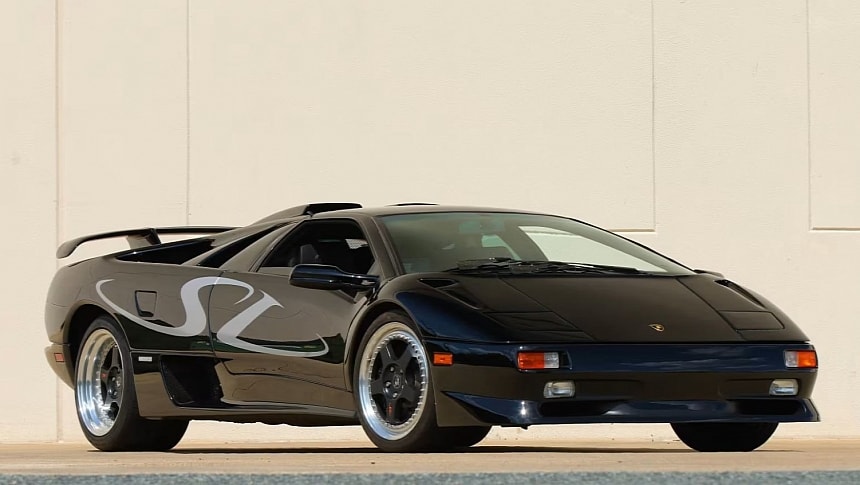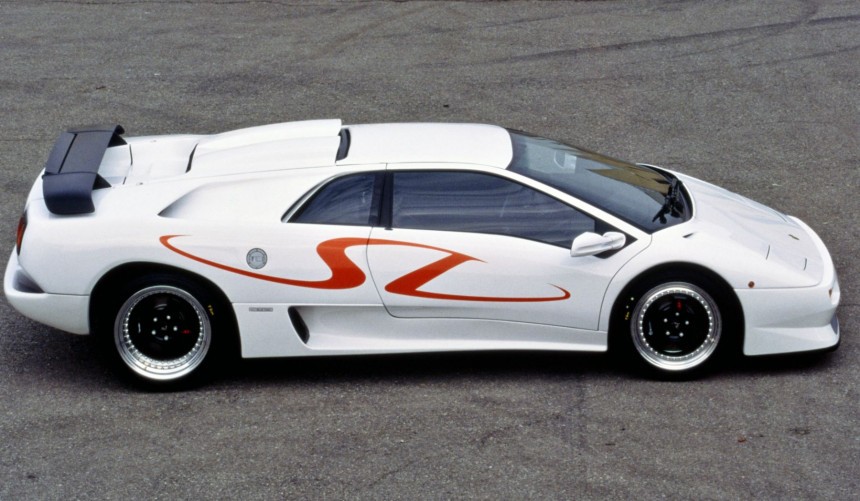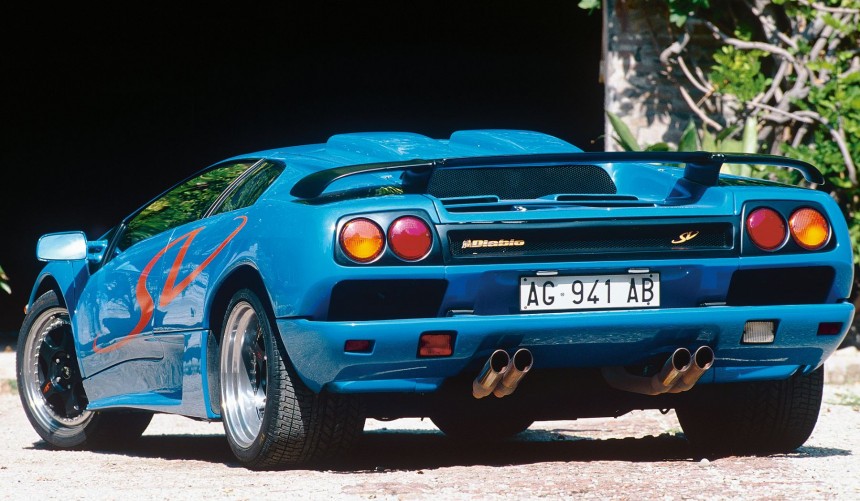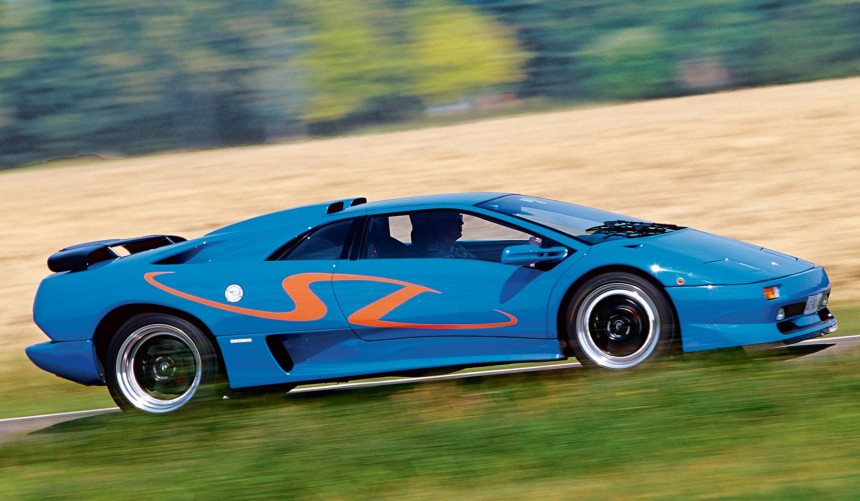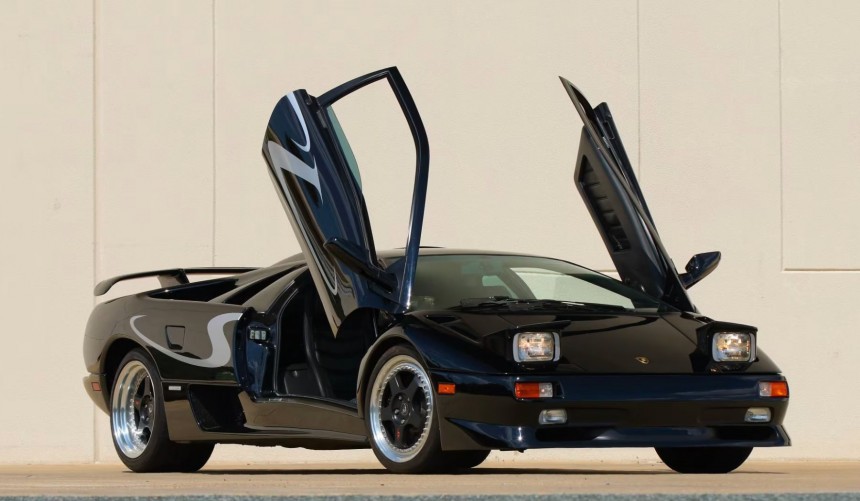As the Diablo became a sophisticated4WD supercar during the second part of the 1990s, Lamborghini surprised everyone with a new, back-to-the-basics model focused purely on performance. Even more surprising, the company made it the cheapest model of the range.
In 1987, the Chrysler Corporation acquired Lamborghini, hoping that it would turn it into one of the best-selling sports car manufacturers in the world.
Unfortunately for the Americans, the acquisition proved a losing bet, as the economy was slow to recover after the infamous 1987 Black Monday stock market crash, and interest in exotic sports cars dwindled.
Before calling it quits and selling the Italian brand in 1993, Chrysler took advantage of Lamborghini's engineering expertise to develop the V10 engine at the heart of the Dodge Viper.
Purchased by a holding company named Megatech, Lamborghini attempted to grow, but sales of its flagship Diablo were slow, despite the introduction of the refined, 4WD member.
Even worse, orders for the base RWD Diablo were almost nonexistent, so the company had to figure out how to revive interest in the model.
The answer to the poor sales problem was an additional model introduced in 1995 at the Geneva Motor Show.
Dubbed SV (Super Veloce) in honor of the most famous version of the Miura, the new Diablo was a pure performance-oriented alternative to the now-unpopular, entry-level RWD model.
More aggressive-looking and more powerful than the standard RWD Diablo, the SV was released with a 10% lower starting price.
While the SV's price efectivelly killed off the standard Diablo, it proved to be a smart decision which led to improved sales.
Aesthetically, the Diablo SV received several features that made it far more appealing than the base model.
The SV's bespoke bumper had single-spot fog lamps, redesigned air intakes, and an optional lip spoiler, while huge side decals let everyone know this was a special Lambo.
Furthermore, the new model was outfitted with several components borrowed or inspired by those of the SE30 and SE30 Jota limited-production anniversary editions.
These included a twin-scoop engine cover, an enlarged grille located between the tail lights for better engine cooling, a Jota-inspired rear bumper, an exposed aluminum filler cap, a lightweight adjustable rear wing with a carbon fiber finish, and unique SV wheels developed by OZ Racing.
As standard, the interior was upholstered in glare-proof Alcantara and boasted a Momo shift knob. However, buyers who wanted a more luxurious cabin could get full-leather upholstery as an option.
Throughout its production run, the SV received minimal cosmetic changes. The most noteworthy came in 1998, when larger front wheels and a new steering wheel equipped with an airbag were added. Then, in 1990, the facelifted SV, which replaced the base RWD model, was fitted with fixed headlights borrowed from the Nissan 300ZX instead of the iconic pop-up units.
At the time of the SV's introduction, the most impressive Diablo available was the VT, which featured electronically adjustable Koni and an AWD system with a viscous-coupling center differential.
However, like the SE30 and its more aggressive Jota counterpart, the SV was based on the standard RWD platform with a reinforced chassis and bigger Brembo rear brakes.
Like all Lambo flagships developed since 1966, the SV was powered by the Giotto Bizzarrini-designed 60-degree V12 mounted in the middle of the chassis.
Though it used the standard Diablo's 5.7-liter, the SV version was upgraded with a re-tweaked, SE30-spec LIE electronic multi-point fuel injection and a free-flow sports exhaust.
Linked to a five-speed manual with improved gearing and a limited-slip differential, the V12 produced 510 hp at 7,100 rpm and 428 lb-ft (580 Nm) of torque at 5,900 rpm, an 18-hp improvement over the engine version in the standard and VT Diablo.
In 1998, the engine was upgraded with a new variable valve timing system that improved output to 530 hp at 7,100 rpm and 446 lb-ft (605 Nm) of twist at 5,500 rpm.
Capable of sprinting from 0 to 62 mph (100 kph) in 3.8 seconds on its way to a top speed of 204 mph (328 kph), the SV was one of the fastest production cars of the era, but also one of the most dangerous.
With an RWD powertrain, a manual transmission, no ABS (until 1999), and only power steering as a modern feature, the SV could be lethal for inexperienced drivers who dared to push it to its limits.
However, those skilled enough to tame the devilish brute were rewarded with a thrilling analog driving experience that a modern 4WD, heavily assisted Lambo just doesn't deliver anymore.
Production of the SV ended after the 1999 model year, with 346 examples leaving the Sant'Agata Bolognese factory. Of those, 344 were hardtops, and two were open-top roadsters.
Today, one of those examples is a prized collector's item that, according to classic.com, has an average value of $276,000.
For more on this iconic Lamborghini, we recommend watching the YouTube video below by Supercar Driver.
Unfortunately for the Americans, the acquisition proved a losing bet, as the economy was slow to recover after the infamous 1987 Black Monday stock market crash, and interest in exotic sports cars dwindled.
Before calling it quits and selling the Italian brand in 1993, Chrysler took advantage of Lamborghini's engineering expertise to develop the V10 engine at the heart of the Dodge Viper.
Purchased by a holding company named Megatech, Lamborghini attempted to grow, but sales of its flagship Diablo were slow, despite the introduction of the refined, 4WD member.
Even worse, orders for the base RWD Diablo were almost nonexistent, so the company had to figure out how to revive interest in the model.
The pure, performance-oriented solution
Dubbed SV (Super Veloce) in honor of the most famous version of the Miura, the new Diablo was a pure performance-oriented alternative to the now-unpopular, entry-level RWD model.
More aggressive-looking and more powerful than the standard RWD Diablo, the SV was released with a 10% lower starting price.
While the SV's price efectivelly killed off the standard Diablo, it proved to be a smart decision which led to improved sales.
Oozing SE30 and SE30 Jota vibes
The SV's bespoke bumper had single-spot fog lamps, redesigned air intakes, and an optional lip spoiler, while huge side decals let everyone know this was a special Lambo.
Furthermore, the new model was outfitted with several components borrowed or inspired by those of the SE30 and SE30 Jota limited-production anniversary editions.
These included a twin-scoop engine cover, an enlarged grille located between the tail lights for better engine cooling, a Jota-inspired rear bumper, an exposed aluminum filler cap, a lightweight adjustable rear wing with a carbon fiber finish, and unique SV wheels developed by OZ Racing.
As standard, the interior was upholstered in glare-proof Alcantara and boasted a Momo shift knob. However, buyers who wanted a more luxurious cabin could get full-leather upholstery as an option.
Throughout its production run, the SV received minimal cosmetic changes. The most noteworthy came in 1998, when larger front wheels and a new steering wheel equipped with an airbag were added. Then, in 1990, the facelifted SV, which replaced the base RWD model, was fitted with fixed headlights borrowed from the Nissan 300ZX instead of the iconic pop-up units.
Rear wheel-driven and slightly more powerful
However, like the SE30 and its more aggressive Jota counterpart, the SV was based on the standard RWD platform with a reinforced chassis and bigger Brembo rear brakes.
Like all Lambo flagships developed since 1966, the SV was powered by the Giotto Bizzarrini-designed 60-degree V12 mounted in the middle of the chassis.
Though it used the standard Diablo's 5.7-liter, the SV version was upgraded with a re-tweaked, SE30-spec LIE electronic multi-point fuel injection and a free-flow sports exhaust.
Linked to a five-speed manual with improved gearing and a limited-slip differential, the V12 produced 510 hp at 7,100 rpm and 428 lb-ft (580 Nm) of torque at 5,900 rpm, an 18-hp improvement over the engine version in the standard and VT Diablo.
In 1998, the engine was upgraded with a new variable valve timing system that improved output to 530 hp at 7,100 rpm and 446 lb-ft (605 Nm) of twist at 5,500 rpm.
They don't make them like this anymore
With an RWD powertrain, a manual transmission, no ABS (until 1999), and only power steering as a modern feature, the SV could be lethal for inexperienced drivers who dared to push it to its limits.
However, those skilled enough to tame the devilish brute were rewarded with a thrilling analog driving experience that a modern 4WD, heavily assisted Lambo just doesn't deliver anymore.
Production of the SV ended after the 1999 model year, with 346 examples leaving the Sant'Agata Bolognese factory. Of those, 344 were hardtops, and two were open-top roadsters.
Today, one of those examples is a prized collector's item that, according to classic.com, has an average value of $276,000.
For more on this iconic Lamborghini, we recommend watching the YouTube video below by Supercar Driver.
